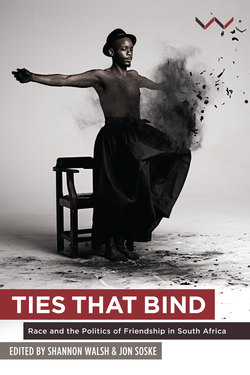Читать книгу Ties that Bind - Shannon Walsh - Страница 8
На сайте Литреса книга снята с продажи.
TIMES, SCALES, AND SPACES OF FRIENDSHIP
ОглавлениеIn Entanglement (2009), Nuttall motivates a reading of historical temporality that stresses the interweaving of the past, present, and future as well as disturbances and interruptions. Following Nuttall, we suggest such a temporal mélange in relation to the times of friendship. Writing histories of friendship requires holding multiple temporal and spatial dimensions together: the chance encounter and the slow unfolding of intimacy, the immanence of togetherness, and the anticipation of a letter or meeting, the prolonged absence, and the counterpoint of remembering. There is no objective moment of friendship: its durations are neither linear nor impersonal. Rather, friendship offers the possibility of rethinking other temporalities (social, economic, political) through the events and memories of two interwoven, but discontinuous, lives. For this reason, friendship (and other forms of intimacy) can also point to a politics that is not located in the present or future, but is both continual and cyclical.
If friendships are often considered to be micro-political, they also provide key links within the structures and networks that enable large-scale, formalized politics. In this respect, the politics of friendship also requires rethinking the problem of scale. Affective relationships organize politics through family alliances, boys’ clubs, political parties, business networks, student organizations, military units, and so on. Friendships frequently develop across multiple sites at once — public and private, visible and invisible — a fact that troubles the liberal conception of democracy with its distinct realms of political and cultural/private life. As a result, friendships can traverse levels of analysis that social scientists and historians often treat separately: the local and the national, the economic and the political, the affective and the material, structure and agency. In post-apartheid South Africa, this aspect of friendship has been discussed in terms of the relationship between the African National Congress’s (ANC) political culture (characterized by strong bonds developed in exile, the underground, and prison) and the impersonal demands of constitutional legality (Booysen 2011). Among its other functions, the debate over corruption attempts to define and regulate the proper relationship between personal loyalties and the functioning of the bureaucratic state.
While friendships exists in multiple times and scales, they also provide spaces for emotional events, exchanges, fantasies, misunderstanding, confidences, and secrets: they create worlds with unique sets of assumptions and expectations. As Derrida (1997) suggests, friendship might be (in some sense) a universal form of relation, but one friend can never replace another. At the same time, certain kinds of friendships are frequently associated with particular sites, especially in contexts where space is policed. As a result, interracial relationships — but also political and artistic friendships that transgressed the conservative mores promoted by the regime — were closely tied to alternative social spaces. The most famous of these locations were the neighborhoods targeted for destruction by the 1950 Group Areas Act: Sophiatown, District Six, and Cato Manor. Celebrated by the Drum generation of writers, these areas came to symbolize a demimonde of dancing and jazz, interracial drinking, cosmopolitanism, and everyday freedoms. Other spaces played a similar social and symbolic role on a smaller scale: the ‘grey areas’ of the art world that developed in neighborhoods such as Hillbrow and the Market Theatre district (Peffer 2009); publications such as Staff Rider and Ravan Press (Vladislavić 2008); and student associations and the campuses of the liberal universities. Reflecting on an afternoon in Paris spent with the poet Breyten Breytenbach, Nkosi (1983) described exile as a space where relationships could develop that would have been impossible within the confines of South African society. Other memoirs recall the experience of prison in similar terms. Despite constrictions and regular abuse, activists from across the country lived together, debated, and developed new understandings of their country through the very different experiences of others (Caine 2011; Desai 2014). As Nelson Mandela (1995: 328) recalled: ‘Prison is an incubator of friendship.’ If each of these locations facilitated alternative forms of sociability and intimacy, they also became venues for intense struggles over privilege and disillusionment with the limitations of friendship.
Across its immense range of periods, contexts, and political organizations, the anti-apartheid struggle also provided a crucial space for the intersection of race, friendship, and the political. Because of its clandestine and semi-clandestine character, oppositional politics frequently operated through dense networks of close personal relationships that overlapped (in varying degrees and in different ways) with the ties of household, family, neighborhood, and workplace. At moments, particular friendships developed a public character and embodied the defiance of apartheid racial norms, for example the relationship between ANC leader Albertina Sisulu and the BC activist Dr Abu Baker Asvat (Soske 2012). Close relationships often drew people into politics. Many memoirs and interviews describe the experience of struggle in terms of the formation of unprecedented friendships that broadened political consciousness and challenged racial (and other) preconceptions. At the same time, influential political cultures within liberation politics, especially those influenced by some form of Leninism, demanded the disciplining of personal affections. Drawing on a Soviet language of the party as family, the ANC underground promoted the subordination of judgment, individual attachments, and intimacy to an impersonal love for the people demonstrated through revolutionary activity (Suttner 2008). Along similar lines, Rassool (2004) argues that a particular political culture, centered on the biography of the liberation organization’s (male) president, either erased or subordinated personal relationships to the larger narrative of the struggle as the nation in the process of becoming. As exemplified by Donald Woods’s (1987) controversial biography of Biko, friendship with a struggle icon could also be invoked to confer authority: writing oneself into the heroic life of the leader became a vehicle to disavow the author’s own whiteness and ventriloquize on the hero’s behalf. Inversely, the central place of affection, trust, and intimacy in liberation politics gave rise to the painful wounds of betrayal as Hugh Lewin (2011) and Dlamini (2014) have explored.
